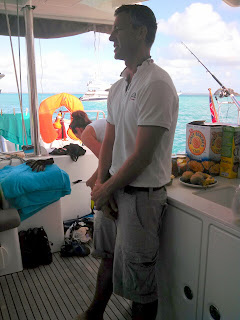This trip was Matt's 40th birthday present and he wanted to go sailing. And while the Captain had been having Matt sail for the past two days, Monday morning brought more than he expected. Previously he asked the Captain if he could help and was given every opportunity including sailing for hours at a time, hoisting sails, drawing line, helping drop anchor, standing watch, etc.
We departed Marigot Bay and headed around the north end of St. Martin on our way to the uninhabited island of Tintamarre. With the wind in our face we took a zig-zag route known as tacking. Along the way the GPS was not giving the necessary information to the Captain and so he summoned an immediate meeting of the men on the ship where the captain gave orders for them to take compass bearings and report locations, chart this information on the nautical map and report to the captain the coordinates and locations as we traversed between St. Martin and the British island of Anguilla. It became tricky when adjustments for magnetic north had to be included in the computation (14 degrees offset).
It was an absolute joy to Matt to embrace all aspects of sailing, and to have a crash course in taking bearings. One of his tasks was to keep the log book while they were charting their locations, writing their coordinates to the exact "second" of longitude and latitude.
Overall the sailing was enjoyable and relaxing, we proceeded at about 4-6 knots. The captain even took us to the stern (back) of the boat and threw a knotted line (rope) in the water to show us how to estimate our speed. The weather was perfect and we eventually arrived at the leeward side of Tintamarre. It was beautiful. With the boat anchored we went ashore, swim or kayak, to explore and play. We crossed the island and found a shipwreck to investigate in the surf on the Windward side of the island and a beach covered with treasures.
More shells and coral than you could carry.
The island adventures ended with dinner aboard and an expectation that we would stay the night in the bay at Tintamarre. But as the sun sank on the horizon we saw that the cresting surf was shifting and that waves were beginning to roll just beyond the boats anchored near the beach. The captain announced that we must leave and seek shelter in another bay or it was likely that at some point in the night these rolling waves would impact the boat and roll her over. We pulled out and backtracked toward St. Martin; heading to Anse Marcel, a protected canyon. We used the motors under the full moon to find a safe spot for the night.

In route the Captain asked Matt to sit at the stern (front) of the boat in the dark and watch to insure we did not hit anyone or anything. As we entered the canyon and could see the lights of the boats in the distance ahead, Matt started yelling to the captain to turn around. Immediately the Captain turned the boat and Matt pointed to giant crashing waves ahead in the middle of what would normally be open water far from shore; these cresting waves were visible only briefly as they crested creating the white foam and producing the unmistakable sound of a crashing wave. The captain identified these waves as the same rolling waves that Tintamarre was about to experience, and he explained that the boats deep in the canyon were trapped until the rolling waves dissipated, and that these waves that were cresting in open water would have likely capsized our boat had we attempted (intentionally or not) to make it over or past these waves. We again turned back and went to the next bay for shelter: Grand Case Bay. At Grand Case we found peaceful calm waters and we anchored for the night.

























































